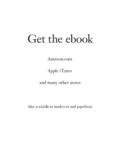Transcription of Get the ebook - yogavidya.com
1 Get the iTunesand many other storesAlso available in hardcover and paperback || - | - || - Y - - Y | || - | || - Y - - Y | - || - % || - Y - - Y | - - || - - % || - Y - - Y | - Y | - - || - | - % || - Y - - Y{ - - Y | - - || | - % || - Y - { - - Y | - - || - | - % || - Y { - - Y | - - - - - | - %}}}
2 || - Y { - - Y | - - - - - | - % || - { - - Y | - - || - - - | - % - { - - Y | - - || - - - | - % || - { - - Y | - - - Y || - - - | - % || - { - - Y | - - Y || - - - | - || - { - - Y | - - Y || - - - | || - { - - | - - Y || - - - || { TheShiva SamhitaA Critical EditionandAn English TranslationJames MallinsonTheShiva SamhitaOur BooksBhagavad GitaGheranda SamhitaHatha Yoga}}}}}}}}
3 PradipikaKamasutraShiva SamhitaTheShiva SamhitaA Critical EditionandAn English TranslationJames MallinsonYog aV id y a .c omAn important message to our readers:The asanas in this book should not be attempted without the supervision of an experienced teacher or prior experience. Many of the other practices should not be attempted at all. The ideas expressed in this book should not be used to diagnose, prescribe, treat, cure, or prevent any disease, illness, or individual health problem. Consult your health care practitioner for individual health care. LLC shall not be liable for any direct, indirect, incidental, special, consequential, or punitive damages resulting from the use of this aV id y , PO Box 569, Woodstock NY 12498-0569 USAC opyright 2007 LLC.
4 All rights reservedRead the Originals is a trademark of i dya .co m is a registered trademark of edition The paper used in this book meets the requirements of the American National Standards Institute/National Information Standards Organization Permanence of Paper for Publications and Documents in Libraries and Archives, ANSI/NISO in the United States of AmericaBritish Library Cataloguing-in-Publication DataA catalogue record for this book is available from the British of Congress Cataloging-in-Publication DataSivasamhita. English & Sanskrit. The Shiva samhita : a critical edition and an English translation / James Mallinson. 1st ed. p. cm. Includes index. ISBN 978-0-9716466-4 -3 (cloth : alk.)
5 Paper) ISBN 978-0-9716466-5-0 (pbk. : alk. paper) 1. Hatha yoga Early works to 1800. I. Mallinson, James, 1970 II. Title. 2007 9 dc22 2006052817 Loretta Claudia and LilyviiContentsIntroduction ixThe Vital Principle 1 Knowledge 26 Practice 40 Mudras 72 Meditation 104 Contributors 169 Index 170ixIntroductionCOMPOSED OV ER five centuries ago.
6 The Shiva Samhita is one of the most celebrated root texts of Hatha Yoga. It includes beautiful teachings found nowhere else. This edition contains the original Sanskrit, properly edited and printed for the fi rst time, and a new, accurate translation thereof. It also features photographs of the asanas and mudras described book is addressed by Shiva to his consort Parvati, and the title means The Collection [of Verses] of Shiva. It proclaims a Yoga teaching, yet also calls itself a tantra. It is such an eclectic collection of Yogic lore that a thorough breakdownof its contents would be nearly as long as the text itself, but the topics covered in its fi ve chapters can be summarized as fi rst chapter starts with the declaration that there is one eternal true knowledge and goes on to mention various methods of liberation and philosophical standpoints, all of which can be transcended by the teachings on Yoga found in the Shiva Samhita.
7 Most of the rest of the chapter is an exposi-tion of nondual Vedantic philosophy in the style of the southern Ta nt r i c school of Sri second chapter describes the macrocosm s micro-cosmic equivalents in the body, the nadis or channels, the internal fi re, and the workings of the jiva, or vital principle. Thex INTRODUCTION third chapter describes the winds in the body, the importance of the guru, the four stages of Yoga, the fi vefold elemental visualizations, and four asanas. The fourth chapter details eleven mudras, which are techniques that result in various Yog ic attainments and magical powers, in particular the raisingof fi fth chapter is the longest and most diverse.
8 It describes the obstacles to liberation, the four types of aspirants, the magical technique of shadow gazing, the internal sound, esoteric centers and energies in the body including Kundalini and the seven lotuses, the king of kings of Yogas, and a threefold mantra whose repetition leads, via global domination, to absorption in the Shiva Samhita was cited extensively by such eminent medieval authors as Narayana Tirtha, Shivananda Sarasvati, Ballala, and Bhavadeva Mishra. The latter s Yuk t a bhavadeva was composed in 1623 CE, while Shivananda Sarasvati s Yoga -cintamani can be dated to approximately 1600 CE. So, allowing some time for the Shiva Samhita to attain a reputation making it worthy of citation, we can suppose 1500 CE as the latest date for the text s composition.
9 The text borrows verses from earlier works, including the Amritasiddhi and the Dattatreya Yoga Shastra. The latter can be dated to approximately the thir-teenth century CE, so we can say that the Shiva Samhita was probably composed between 1300 and 1500 also contains a good clue as to where it was composed. In the fi fth chapter there is a rather forced attempt to impose a new (and topographically unlikely) homology on top of the usual schema in which the Ida and Pingala nadis are equated with the Ganga, or Ganges, and Yamuna rivers, and the central Sushumna nadi with the Sarasvati, the legendary subterranean INTRODUCTION xiriver said to join the Ganga and Yamuna at their confl uence in Prayaga, modern-day Allahabad.
10 In verses and -139, t he Ganga is instead equated with Sushumna, and Ida and Pingala with the Varana and Asi rivers, small tributar-ies of the Ganga which fl ow in Varanasi. Thus it seems likely that the text was composed in or around Varanasi. The author or compiler, however, remains translation of the Shiva Samhita into English by Chandra Vasu in 1914 fou nd a n aud ience amongst Yoga afi -cionados around the globe. It might be asked if another trans-lation is needed. (There have been other translations too, but all are either based on Vasu s or are inferior to his.) Well, there are many shortcomings to Vasu s work ; I shall mention only the most important ones here.


